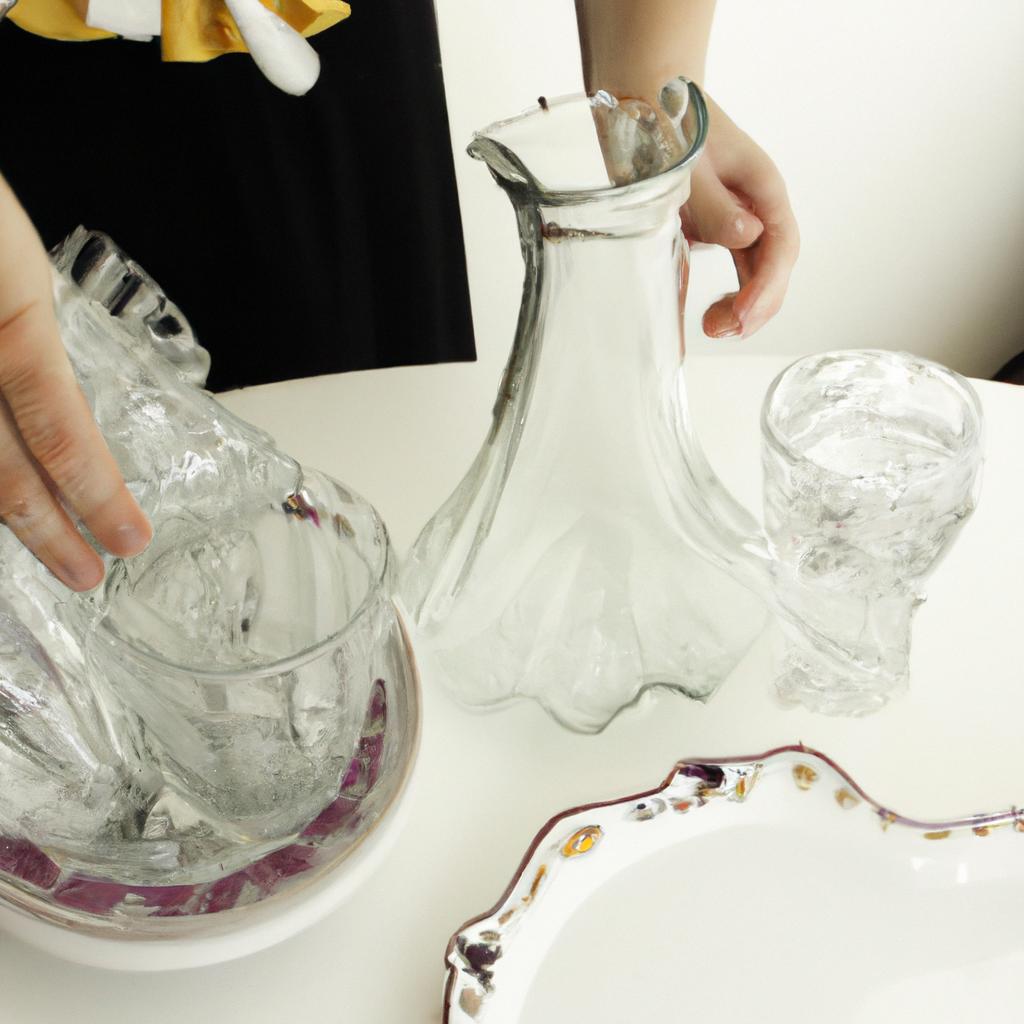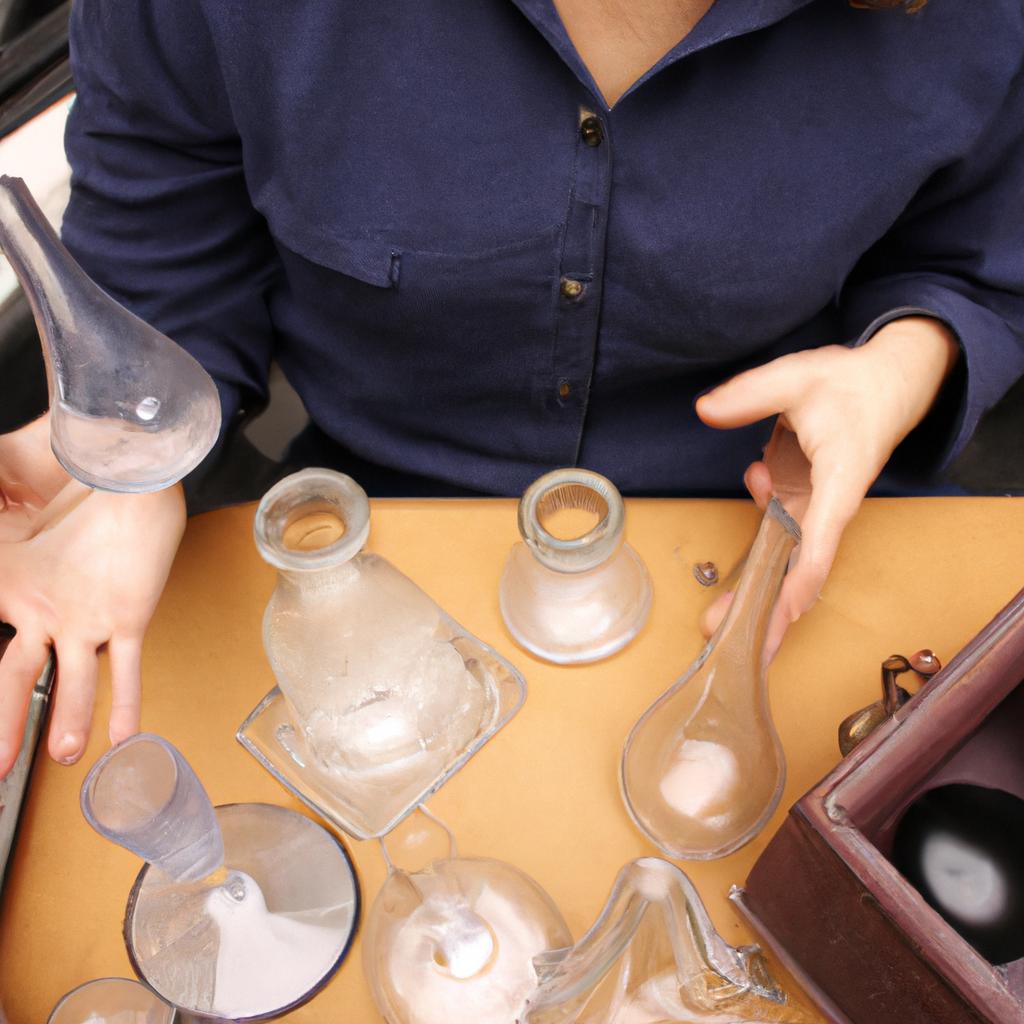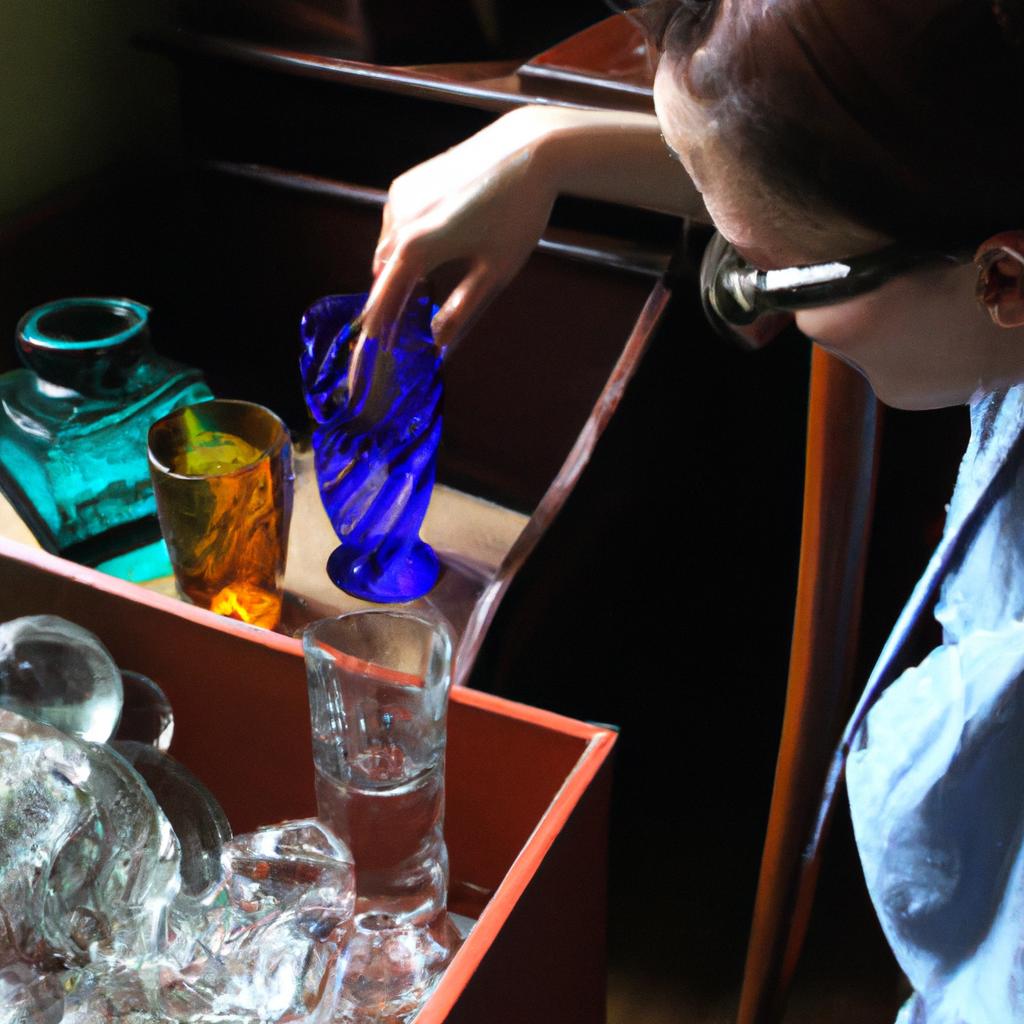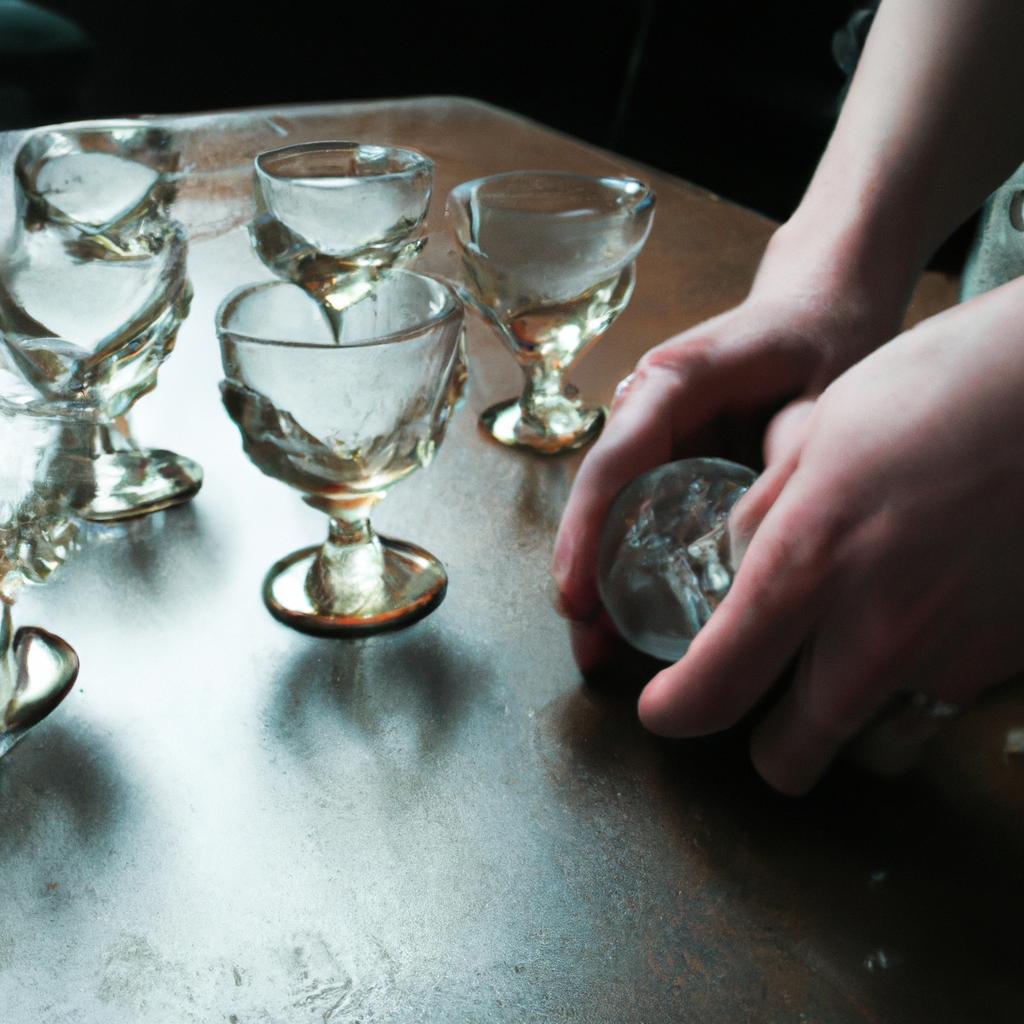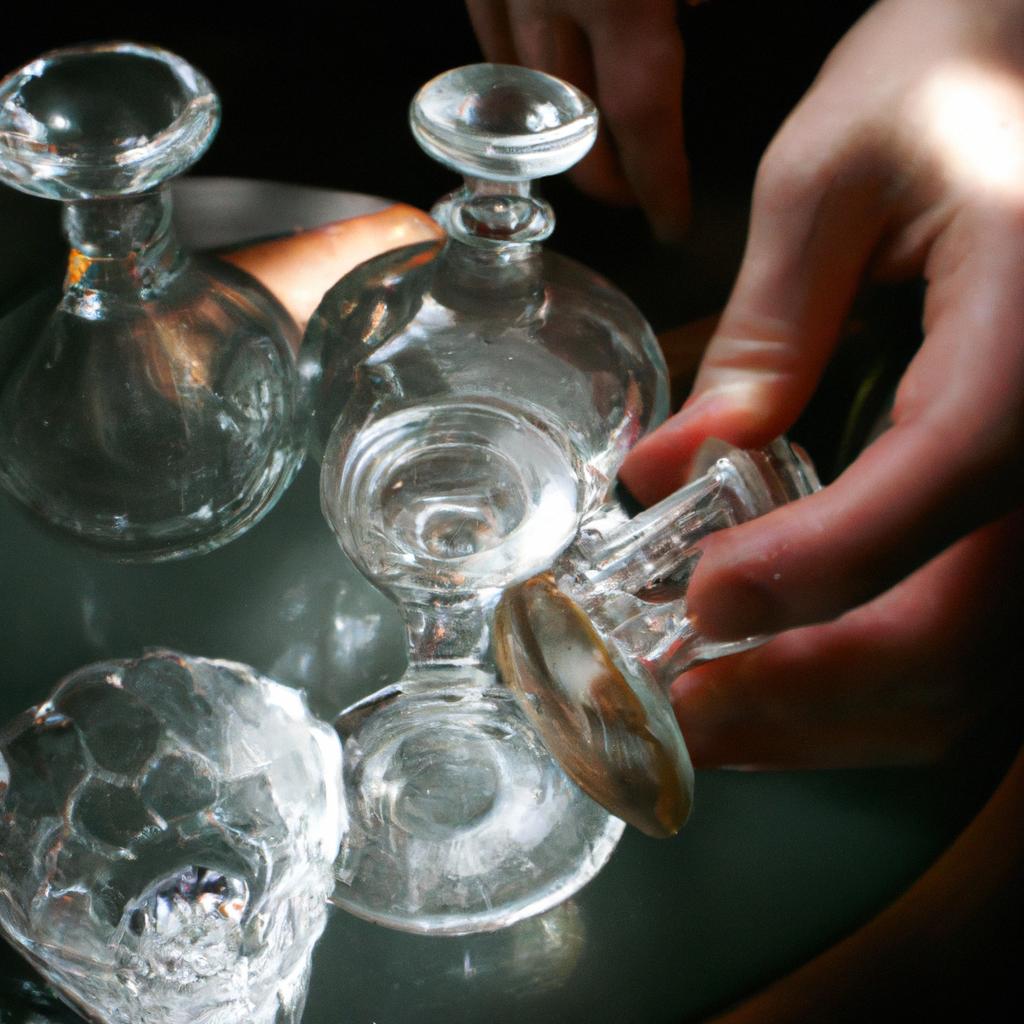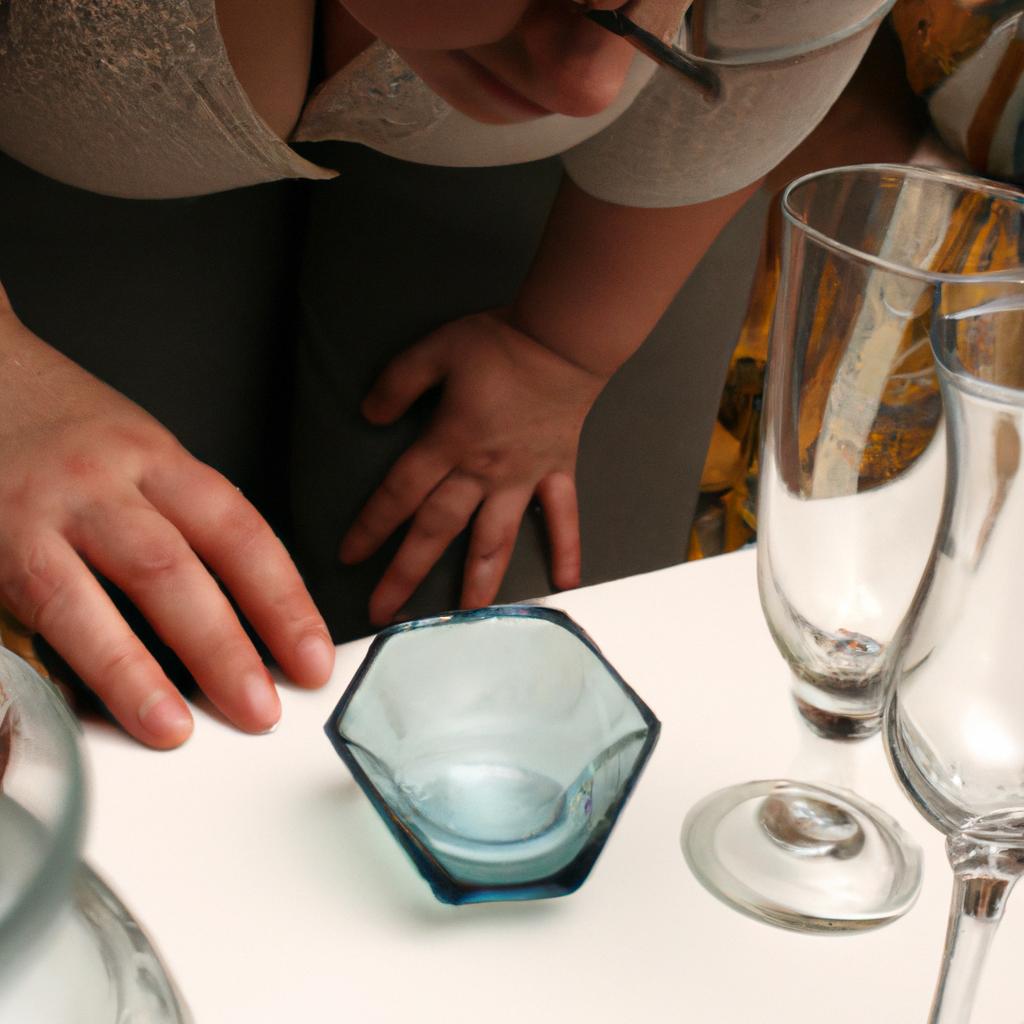Guide to Collecting Vintage Glassware: Antiques and Collectibles
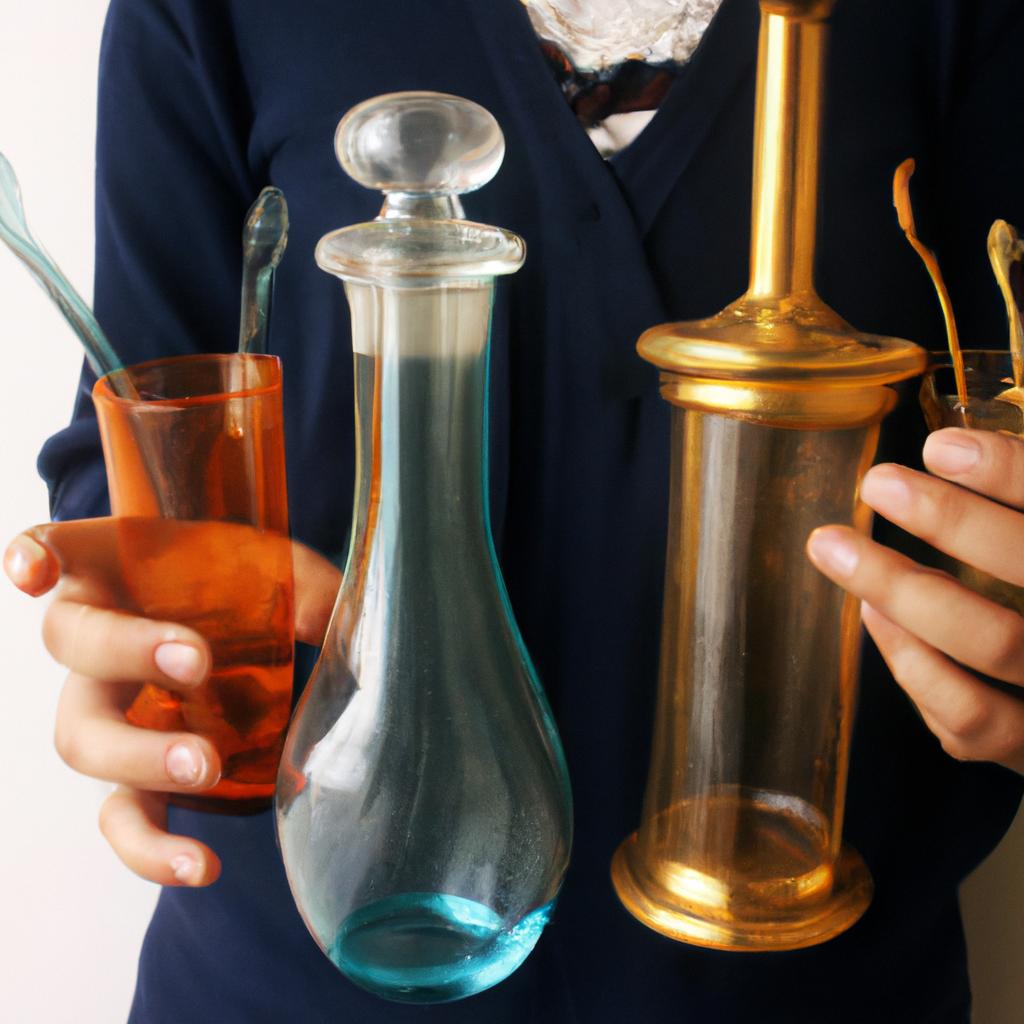
Vintage glassware holds a unique charm and allure that captivates collectors worldwide. Whether it be delicate crystal stemware, colorful Depression-era pieces, or elegant art deco designs, these relics from the past transport us to bygone eras filled with nostalgia and elegance. This article serves as a comprehensive guide for those interested in venturing into the world of collecting vintage glassware. By exploring the rich history, identifying key characteristics, understanding market trends, and learning proper care techniques, enthusiasts can embark on an exciting journey towards building their own curated collection.
To illustrate the fascinating realm of vintage glassware collecting, let us consider a hypothetical case study involving Emily, an avid collector based in rural Indiana. After inheriting her grandmother’s beautiful cut-glass punch bowl set, Emily developed a keen interest in antique glass pieces. Determined to expand her knowledge and grow her collection further, she embarked on a quest to learn about different styles of glassware and their historical significance. Through meticulous research and guidance from expert resources like books and online communities dedicated to antique collectibles, Emily soon found herself immersed in the captivating world of vintage glassware. As she delved deeper into this hobby, she discovered not only the aesthetic value but also the potential investment opportunities that lie within the world of vintage glassware.
Emily quickly realized that certain types of vintage glassware, such as mid-century modern designs and rare art glass pieces, could appreciate in value over time. With this newfound knowledge, she began attending antique shows, flea markets, and estate sales in search of hidden gems that could potentially become valuable additions to her collection.
As Emily continued her journey, she learned the importance of identifying key characteristics that distinguish different styles of vintage glassware. For example, she discovered that Depression-era glass often featured vibrant colors and intricate patterns, while art deco designs were characterized by geometric shapes and bold lines. Armed with this information, Emily became more confident in her ability to recognize valuable pieces amidst a sea of options.
To ensure the longevity of her collection, Emily also familiarized herself with proper care techniques for vintage glassware. She learned to handle delicate pieces with care, avoiding sudden temperature changes and using mild cleaning agents specifically formulated for glass. By following these guidelines, Emily was able to preserve the beauty and integrity of her precious finds.
In addition to building her own collection, Emily actively engaged with online communities dedicated to vintage glassware collecting. Through forums and social media groups filled with fellow enthusiasts and experts alike, she gained valuable insights into market trends and emerging collectible items. This allowed her to make informed decisions when acquiring new pieces and even participate in trading or selling opportunities within the community.
Over time, Emily’s dedication paid off as her collection grew both in terms of aesthetic value and potential investment returns. Her passion for vintage glassware not only brought joy but also opened doors to new connections and opportunities within the collecting world.
In conclusion, collecting vintage glassware is not merely a hobby but an immersive experience that combines history, aesthetics, market awareness, and preservation skills. As demonstrated through Emily’s case study, venturing into this fascinating realm can lead collectors on a captivating journey filled with nostalgia, elegance, and potentially rewarding investments. Whether you are a beginner or seasoned collector, the world of vintage glassware welcomes all who appreciate its unique charm and allure.
Understanding the history and origins of vintage glassware
Glass has been used for centuries to create beautiful and functional objects. From delicate drinking glasses to intricately designed vases, vintage glassware holds a special place in the world of antiques and collectibles. To fully appreciate these treasures, it is important to delve into their fascinating history and understand the various factors that contribute to their value.
Imagine you stumble upon an exquisite hand-blown vase at a flea market. Its elegant curves, vibrant colors, and intricate patterns immediately catch your eye. As you hold it in your hands, you can’t help but wonder about its story – who crafted this masterpiece? Where was it made? What time period does it belong to? These questions serve as a starting point for unraveling the rich history behind vintage glassware.
To explore further, let’s consider four key aspects that impact the historical significance and desirability of vintage glassware:
-
Provenance: The origin of a piece plays a crucial role in determining its value. Knowing where a particular item was manufactured or which renowned glassmaker created it adds depth to its story. For example, pieces from famous European manufacturers like Lalique or Murano tend to be highly sought after due to their reputation for exceptional craftsmanship.
-
Style and Design: Vintage glassware encompasses numerous styles ranging from Art Nouveau to Mid-Century Modern. Each era brought forth unique design elements inspired by prevailing artistic movements or cultural influences. By recognizing distinctive characteristics such as geometric shapes during the Art Deco period or organic forms during the Scandinavian design movement, collectors can identify specific styles they are drawn to.
-
Techniques: The techniques employed in creating vintage glassware showcase the skill and innovation of artisans throughout history. From blown glass to cut crystal, each technique requires precision and expertise. Some examples include cameo glass with its layered colors achieved through etching or overlay technique using multiple layers of differently colored glass.
-
Condition: The condition of vintage glassware greatly affects its value and collectability. Items in pristine condition, free from chips, cracks, or repairs, are generally more desirable to collectors. However, certain imperfections like controlled bubbles or minor wear can add character and authenticity to the piece.
In understanding these aspects, we gain a deeper appreciation for the artistry and craftsmanship behind vintage glassware. As we move forward into the exciting world of collecting, it is essential to recognize and identify different types and styles of vintage glassware
Identifying different types and styles of vintage glassware
Understanding the history and origins of vintage glassware provides valuable context for collectors. By delving into the background, it becomes easier to appreciate the craftsmanship and significance of these pieces. For instance, let’s consider a case study: an intricately designed Art Deco glass vase from the 1920s. This particular piece exemplifies the elegance and geometric motifs that characterized this influential design movement.
To fully grasp the nuances of vintage glassware, it is important to identify different types and styles. Here are some key categories to keep in mind:
- Depression Glass: Produced during the Great Depression era, this translucent colored glass became immensely popular due to its affordability.
- Carnival Glass: Known for its iridescent finish, carnival glass was first produced in the early 1900s as a more affordable alternative to expensive art glass.
- Cut Glass: Characterized by intricate patterns cut into the surface using rotating abrasive wheels, cut glass has been admired for centuries for its dazzling brilliance.
- Murano Glass: Hailing from Venice, Italy, Murano glass boasts vibrant colors and intricate designs crafted by skilled artisans on the island of Murano.
By familiarizing ourselves with these distinct types and styles of vintage glassware, we can better navigate our collection journey and make informed decisions when acquiring new pieces.
| Type | Characteristics | Notable Examples |
|---|---|---|
| Depression Glass | Affordable, colorful | Pink Doric Pitcher |
| Carnival Glass | Iridescent finish | Fenton Dragon & Lotus Bowl |
| Cut Glass | Intricate patterns | American Brilliant Period Punch Bowl |
| Murano Glass | Vibrant colors, elaborate designs | Seguso Vetri d’Arte Vase |
Appreciating the historical relevance and recognizing different types and styles sets a strong foundation for becoming a knowledgeable collector.
Tips for assessing the condition and authenticity of antique glassware
Identifying different types and styles of vintage glassware is a crucial skill for any collector or enthusiast. By understanding the unique characteristics and attributes of various glassware pieces, one can make informed decisions about their collection. Let’s delve into this topic further.
To illustrate the importance of identifying different types and styles, let’s consider a hypothetical scenario where you come across an exquisite glass vase at an antique store. At first glance, it appears to be a classic example of Art Nouveau design with its flowing lines and organic motifs. However, upon closer inspection, you notice intricate floral patterns that resemble those found in Victorian-era glassware. This observation prompts you to consult reference materials and experts to determine if your initial assessment was correct or if the piece represents a blend of multiple styles—a discovery that would greatly enhance its value.
When identifying vintage glassware, there are several key factors to consider:
- Shape: Glassware comes in various shapes such as bowls, vases, pitchers, stemware, and more. The form often reflects the purpose or function of the piece.
- Color: Different eras favored specific colors in glass production. For example, Depression-era glass is known for vibrant hues like pink, green, and blue.
- Decorative Techniques: Understanding techniques like etching, cutting, enameling, or even applied decorations can provide insights into the time period and style of a particular piece.
- Markings: Many manufacturers stamped or engraved their products with logos or signatures—these markings offer valuable clues when researching origins and authenticity.
- Discovering rare pieces that showcase exceptional craftsmanship can ignite excitement within collectors.
- Uncovering hidden gems at thrift stores or estate sales can elicit feelings of anticipation and thrill.
- Holding an item that has survived decades or even centuries invokes awe at its enduring beauty.
- Sharing knowledge and stories about acquired pieces fosters a sense of community and connection among fellow collectors.
In addition to these points, it can be helpful to consult reference books, online resources, or join collector forums for further insights. But the journey doesn’t end here; exploring popular manufacturers and designers of collectible glassware will provide even more depth to your understanding of this fascinating realm. So let’s move on to the next section: “Exploring popular manufacturers and designers of collectible glassware,” where we delve into the influential figures that have shaped the world of vintage glassware collecting.
Exploring popular manufacturers and designers of collectible glassware
Assessing the condition and authenticity of antique glassware requires careful examination and knowledge about various factors that can affect its value. By understanding these aspects, collectors can make informed decisions when adding pieces to their collection. Let’s explore some useful tips for assessing the condition and authenticity of vintage glassware.
To illustrate this process, let’s consider a hypothetical case: a collector comes across a beautiful Art Deco vase at an estate sale. The first step is to visually inspect the piece for any signs of damage or restoration. This includes looking for chips, cracks, repairs, or uneven wear patterns that may indicate alterations or poor handling over time.
Next, it is essential to examine the base of the vase for markings or signatures from the manufacturer. Many reputable manufacturers engraved their logo or signature on their creations, providing valuable clues about its origin and authenticity. Comparing these marks with reference books or online resources can help identify the manufacturer and determine if it matches the claimed period.
Furthermore, evaluating the overall quality of craftsmanship is crucial in determining authenticity. Vintage glassware often exhibits characteristics such as hand-blown bubbles, pontil marks (the rough spot where the object was detached from the blowing rod), and intricate details achieved through techniques like cutting or enameling. These telltale signs can provide insights into whether a piece is genuinely old or a modern reproduction trying to imitate older styles.
When examining antique glassware, keep in mind these important considerations:
- Provenance: Understanding the history and previous ownership of a particular item adds value and helps authenticate its origin.
- Rarity: Rare pieces are highly sought after by collectors due to their scarcity.
- Condition: Pristine condition without significant damages contributes significantly to an antique’s value.
- Historical significance: Glassware associated with notable events or famous individuals often holds greater allure for collectors.
In conclusion, meticulously assessing the condition and authenticity of vintage glassware involves visually inspecting for damage, researching manufacturer markings, and evaluating craftsmanship. By applying these tips, collectors can make informed decisions while building their collection. Now let’s delve into the world of popular manufacturers and designers of collectible glassware.
Building a collection: where to find and buy vintage glassware
Example:
To better understand the world of vintage glassware, let’s examine one notable manufacturer and its impact on collectors. Take for instance, Fenton Art Glass Company, which was founded in Ohio in 1905. Known for their exquisite handcrafted glass pieces, Fenton became highly sought-after by enthusiasts due to their wide range of designs and techniques.
One can explore various popular manufacturers and designers when building a collection of vintage glassware. Here are some key players in this realm:
- Tiffany & Co.: Renowned for their elegant stained glass creations, Tiffany & Co.’s contributions to the art of glassmaking have left an indelible mark on the industry.
- Lalique: Founded by René Lalique in France during the late 19th century, Lalique is celebrated for its intricate crystal work and exceptional craftsmanship.
- Steuben Glass Works: Established in New York in 1903, Steuben Glass Works gained recognition for producing high-quality decorative items that seamlessly blended functionality with artistic flair.
- Murano: Located near Venice, Italy, Murano has been synonymous with fine glassmaking since the 13th century. Collectors admire Murano glasswares’ vibrant colors and delicate forms.
Table showcasing renowned manufacturers and designers:
| Manufacturer/Designer | Country | Notable Characteristics |
|---|---|---|
| Fenton | USA | Handcrafted beauty |
| Tiffany & Co. | USA | Elegant stained glass |
| Lalique | France | Intricate crystal work |
| Steuben Glass Works | USA | Blend of function and artistry |
| Murano | Italy | Vibrant colors, delicate forms |
Exploring these prominent figures allows collectors to appreciate different styles, techniques, and historical significance within the realm of vintage glassware. By familiarizing oneself with various manufacturers and designers, collectors can develop a discerning eye for quality pieces that align with their preferences.
Now that we have explored popular manufacturers and designers of collectible glassware, let’s move on to building a collection by discovering where to find and purchase these valuable vintage items.
Caring for and preserving your valuable glassware collection
Imagine stumbling upon a beautiful antique glass vase at an estate sale. Its intricate design and rich colors immediately catch your eye, making you wonder about its history and potential value. Determining the authenticity and worth of vintage glassware is crucial for collectors to make informed decisions. In this section, we will explore various factors that contribute to evaluating the value and authenticity of vintage glassware.
Firstly, one must consider the maker or manufacturer of the glassware. Certain companies have gained recognition for their craftsmanship and artistic designs throughout history. For instance, a piece attributed to renowned Art Nouveau artist Émile Gallé would hold more value than an unknown artisan’s creation from the same era. Researching reputable manufacturers can provide insight into the quality and desirability of specific pieces.
Secondly, analyzing the condition of vintage glassware is essential in determining its value. Factors such as chips, cracks, or repairs can significantly affect both aesthetic appeal and monetary worth. A well-preserved item with minimal damage will generally be more sought after by collectors compared to heavily damaged ones. Additionally, examining any markings or signatures on the piece can offer clues regarding its age and origin.
Lastly, scarcity plays a significant role in assessing value within the world of vintage glassware collecting. Limited production runs or discontinued patterns tend to command higher prices due to their rarity. Collectors often seek out unique pieces that are not commonly found in mainstream markets. Pieces from limited editions or those created by renowned artists are particularly coveted among enthusiasts.
To further illustrate these considerations, let us take a closer look at an example:
Case Study: The Tiffany Favrile Vase
- Maker/Manufacturer: Tiffany & Co.
- Condition: Excellent; no visible damage
- Rarity: Limited edition design
- Estimated Value: $4,000 – $6,000
In conclusion,
Evaluating the value and authenticity of vintage glassware requires a combination of knowledge, research, and careful examination. By considering factors such as the maker, condition, and rarity of a piece, collectors can make informed decisions about their acquisitions. Remember that each item has its own unique story to tell, making the journey of collecting antique glassware all the more fascinating.
Table: Factors Influencing Vintage Glassware Value
| Factor | Description |
|---|---|
| Maker | Reputable manufacturers or renowned artists increase desirability |
| Condition | Minimal damage enhances aesthetic appeal and monetary worth |
| Rarity | Limited production runs or discontinued patterns are valued for their scarcity |
Note: The values mentioned in this section are hypothetical and may vary based on market conditions and individual appraisals.

